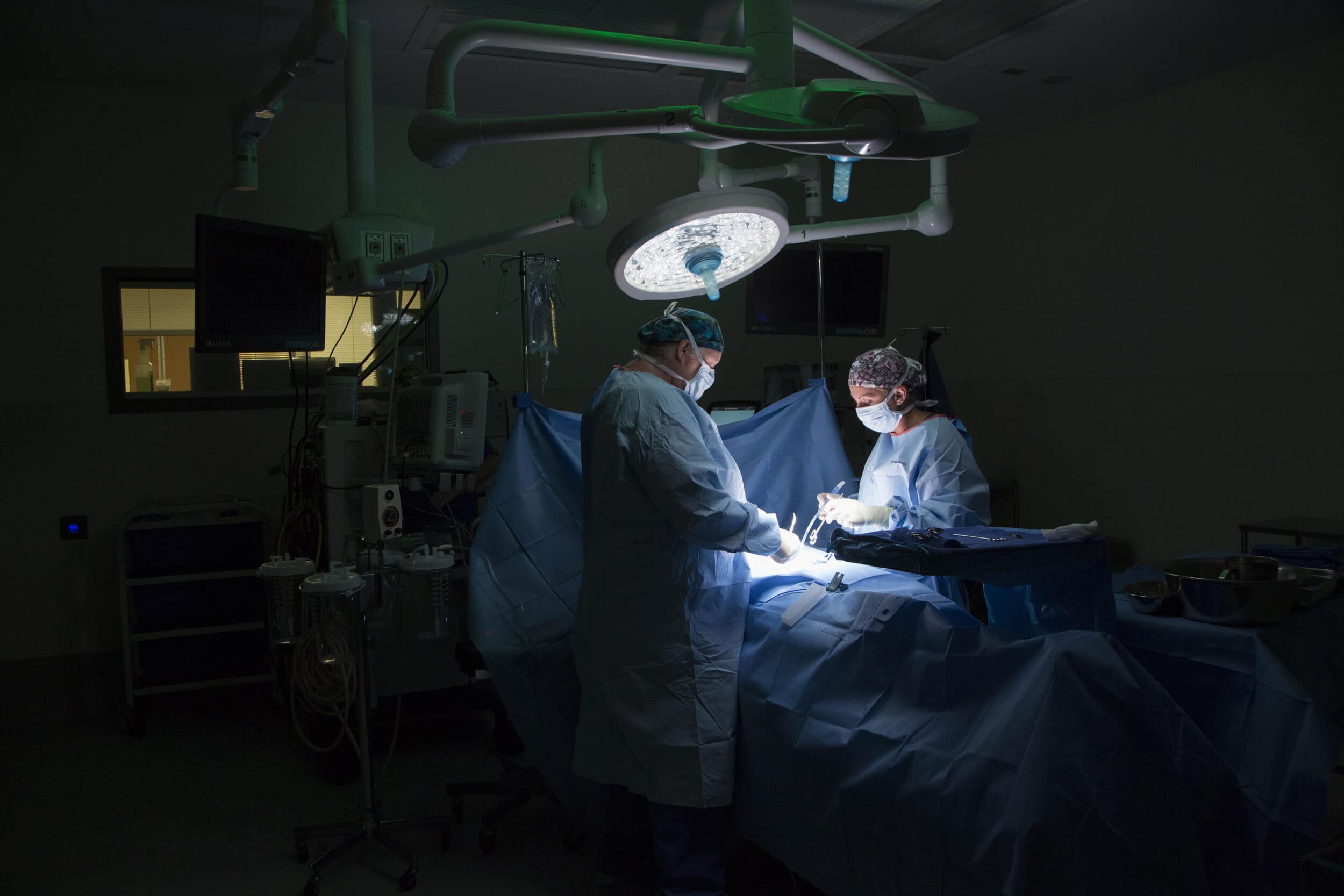The Surgery Department at Windom Area Health performs inpatient and outpatient surgical procedures.
The Surgical Department's vision is to provide comprehensive care to all patients utilizing the wide variety of specialty services that are available at Windom Area Health. A large variety of specialty services are utilized in this area including: Orthopedics, Obstetrics and Gynecology, Urology, Podiatry, and Ophthalmology.
For more information, contact Surgical Services at 507-831-0652.

Robotic-Assisted Surgery
Some procedures at Windom Area Health can be performed with minimally-invasive, robotic-assisted surgery via the da Vinci Xi robotics platform.
The da Vinci Xi is a tool that surgeons can use to perform soft-tissue surgeries. These include procedures such as hysterectomies, hernia repairs, cholecystectomies, colectomies, and appendectomies. The system is not sued for orthopedic procedures that deal with bone structure, such as joint replacements.
The da Vinci surgical system is designed to help surgeons perform minimally-invasive surgery by offering them high-definition 3D vision, a magnified view, and robotic and computer assistance. They use specialized instrumentation, including a miniaturized surgical camera and wristed instruments (i.e., scissors, scalpels, and forceps) that are designed for increased precision, smaller incision sites, and faster recovery time for patients.
For more information on robotic-assisted surgeries offered at Windom Area Health, call 507-831-3345.
Surgery and Scope Procedures
Find out more about the common surgical procedures and preventative scope screenings performed at Windom Area Health.
Colonoscopy
A scope procedure that examines the lower part of the gastrointestinal tract (colon or large intestine) to search for polyps, cancer, or other diseases.
Gastroscopy
A scope procedure that examines the upper digestive tract, traveling down the food pipe, the stomach, and the first part of the small intestine to help identify conditions such as gastritis or peptic ulcers.
Laparoscopic Procedures
This is a minimally invasive surgical technique that allows the surgeon to access the inside of the abdomen and pelvis without having to make large incisions. Common issues a Laparoscopic Procedure can help identify are hernias, appendicitis, and intestinal blockages.
Gallbladder Removal
This is a very common procedure to remove the gallbladder. Gallbladder removal is a common treatment for gallstones.
Excision of Lesions & Tumors
Also known as shave excision, this procedure is a treatment that surgically removes skin cancer and various skin lesions.
Breast Cancer Excision & Biopsy
A breast cancer excision (also known as a lumpectomy or wide local excision) is a surgical procedure used to remove an area of cancer from the breast, leaving behind as much normal breast tissue as possible. The area of cancer is removed and some of the surrounding breast tissue.
A breast cancer biopsy is when a small piece of tissue is removed from the suspicious area to be tested for cancer cells.
Lymph Node Biopsy
This is a procedure in which a lymph node or piece of a lymph node is removed for examination to possibly detect cancerous tumors, noncancerous masses, or infection.
Colectomy
This is a surgical procedure to remove part of all of the colon. This can help treat issues such as blockages or twisting in the colon as well as to remove or prevent colon cancer or other tumors.
Appendectomy
This is the surgical removal of the appendix. This is normally performed as an urgent or an emergency procedure to treat appendicitis or may occur as a result of an obstruction in part of the appendix.
Hernia Repairs
A surgical procedure to push a hernia back into place, tie it off, or remove it.
Incision & Drainage Procedures
A minor surgical procedure to release pus or pressure built up under the skin, such as with an abscess.
Arthroscopic Knee Repair
A minimally invasive surgical procedure that allows the surgeon to see inside your joint to repair some types of joint damage without making a large incision.
Some problems that are corrected with this type of procedure are ACL or meniscus tears.
Arthroscopic Shoulder Repair
A minimally invasive surgical procedure that allows the surgeon to see inside your joint to repair some types of joint damage without making a large incision.
Some problems that are corrected with this type of procedure are shoulder impingement and rotator cuff tears.
Total Joint Replacements (Knee & Hip)
A surgical procedure to replace a damaged joint with an artificial joint made of metal, plastic, or a ceramic device, called a prosthesis.
If you are planning to have a Total Hip or Knee Replacement at Windom Area Health, you will go through Total Joint Camp.
Total Joint Camps are held to help aid in the uncertainties of total joint replacement surgery, supplying information from departments such as Billing, Infection Prevention, Surgery, Nursing and Rehabilitation. Each department has a scheduled time to meet with future joint recipients and explain what to expect, from pre-op, surgery, discharge, post-op therapy and answer any questions.
Carpal Tunnel
A surgical procedure to release pressure on the median nerve to release the symptoms of carpal tunnel.
Trigger Finger
This is a surgical procedure to increase the space for the flexor tendon to move with the goal of making it easier to bend and straighten the finger.
C-Sections
Even for a planned vaginal birth, a c-section may be necessary. Labor that isn’t progressing, health concerns for the mother or baby, birth of multiple babies, a breech or transverse position, or a previous c-section or uterine surgery may result in a Cesarean delivery.
Your doctor will discuss the procedure with you before your due date. If you do have a c-section, your healthcare provider will see you for ongoing care in the weeks and months after delivery.
Incontinence Repair
If you have accidental loss or leaking of urine, your doctor can help you explore non-surgical treatment options and determine if surgical repair is necessary to resolve this issue.
The most common surgical treatment is the sling procedure, where urinary incontinence is resolved by inserting a synthetic mesh sling to help support your urethra and keep it closed, especially when you cough or sneeze.
Diagnostic Laparoscopy
If you experience pain and discomfort in your abdominal area, especially if there are signs of a potential growth with unclear x-ray, ultrasound, or other test results, your doctor may perform a diagnostic laparoscopy. This procedure may also be performed after an accident to check for injury to abdominal organs or before cancer treatment.
Small cuts in the abdomen are made and the laparoscope is inserted. General anesthesia is required, and most patients can return to normal activities a week after surgery. Your doctor will talk with you about this procedure if it is right for you.
Hysteroscopy
A hysteroscope is a thin device (similar to a telescope) that your doctor can insert through your vagina into your uterus. Images of your uterus are visible on a screen so that your doctor can diagnose or treat problems, including understanding the cause of repeat miscarriage, removing adhesions, locating an IUD, or to perform sterilization.
A hysteroscopy is an outpatient procedure that may require anesthesia. You should recover quickly, but may experience some discomfort or bloody discharge after the procedure.
Hysterectomy
A wide variety of conditions can affect your reproductive system, including fibroids and endometriosis, resulting in irregular, heavy vaginal bleeding, and/or chronic pelvic pain. Women experiencing these conditions are often treated with a hysterectomy, or the removal of the uterus.
A traditional hysterectomy requires a large incision below the navel. Windom Area Health offers a state-of-the-art, less invasive procedure called the da Vinci Hysterectomy, resulting in significantly less pain and discomfort, small incisions for faster recovery and minimal scarring, less blood loss, a shorter post-surgery hospital stay, and better outcomes and patient satisfaction. Your doctor will help you determine which procedure is the best fit for you.
Salpingectomy
If you are experiencing an ectopic pregnancy or want permanent and non-reversible birth control sterilization, you may be treated with a salpingectomy where one or both fallopian tubes are removed. After a bilateral salpingectomy, pregnancy is still possible through IVF if you have a uterus and wish to become pregnant.
Recovery for a laparoscopic salpingectomy takes approximately 14 days, while recovery from an abdominal operation takes four to six weeks. Your doctor can help you determine what type of surgery is best for you.
Utero-Vaginal Prolapse Repair
Utero-vaginal prolapse occurs when muscles and tissue no longer support the organs in your pelvis, causing them to drop. You may experience difficulty completely emptying your bladder, a feeling of fullness in your pelvis, lower back pain, difficulty inserting tampons or applicators, or organs bulging out of your vagina.
There are non-surgical options to treat prolapse, but this condition may require surgery. Your doctor can help you explore a variety of non-surgical and surgical options.
Cataracts
This is commonly performed procedure to remove a cloudy lens that is causing vision problems and replacing it with a new artificial lens.
YAG Laser Surgery
This is a laser treatment is sometimes used after a cataract surgery that helps restore clear vision if it becomes cloudy again.
Cystoscopy
This procedure is an endoscopy to look inside the bladder with a thin camera, called a cystoscope. This procedure can help find problems with the urinary tract such as early signs of cancer, infection, narrowing, blockage, and more.
Lithotripsy
This is a noninvasive procedure that uses shock waves to break up stones in the kidney and parts of the ureter that are too large to pass through the urinary tract.
Circumcision
Vasectomy
Bunionectomy
A procedure to reduce the pain and correct the deformity caused by a bunion.
Fracture Repair
Hammer Toe Repair
A procedure to straighten a curled toe that causes problems and hasn't responded to other treatments. The type of procedure will depend on the severity of the condition.
Neuroma Surgery
For those suffering from Morton's neuroma, this procedure is carried out to remove the part of the damaged nerve or to take pressure off the nerve by creating space around it.
